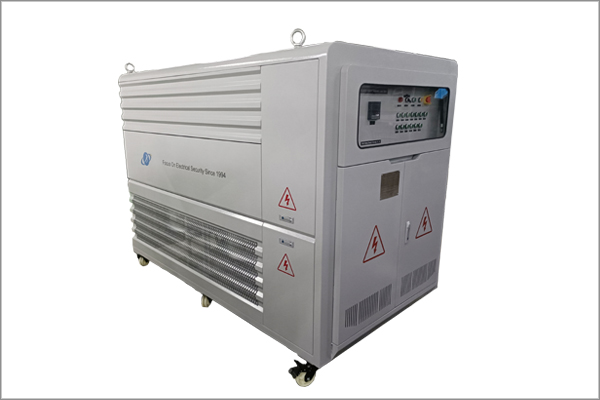Precautions for Using Resistive Load Banks
Time:2025-07-02
As an important device in the power system for simulating loads and detecting the performance of power supply equipment, the correct use of resistive load banks is crucial for ensuring equipment safety, improving the accuracy of detection, and extending the service life of equipment. When using resistive load banks, the following precautions must be strictly observed:
I. Safe Operation
Personnel Qualifications: Operators of resistive load banks must possess professional electrical knowledge, undergo systematic training, and obtain relevant qualification certificates. Unauthorized operation by untrained personnel is strictly prohibited.
Protective Equipment: Before operation, operators must wear protective equipment such as insulated gloves and insulated shoes to avoid electric shock accidents.
Power - Off Operation: For any maintenance, repair, or connection and disconnection operations between the load bank and power supply equipment, the power must be cut off first. Use professional tools for voltage testing to ensure that there are no residual charges before proceeding with the operation.
II. Installation and Environmental Requirements
Installation Location: Select a well - ventilated, dry place without corrosive gases to install the load bank. Avoid installing it in humid, high - temperature environments or places with flammable and explosive substances to prevent equipment damage due to moisture and to avoid risks such as fires and explosions.
Stable Installation: Ensure that the load bank is installed stably to prevent internal components from loosening or connection parts from falling off due to vibration. At the same time, leave enough space at the installation location to facilitate daily inspection and maintenance by operators.
Grounding Requirements: The resistive load bank must be reliably grounded, and the grounding resistance should meet relevant standard requirements. Good grounding can effectively prevent the equipment casing from being charged, ensuring the safety of personnel and equipment.
III. Operation and Monitoring
Parameter Setting: Before use, accurately set the parameters of the load bank according to the actual test requirements, such as load power, voltage, current, etc. It is strictly prohibited to operate beyond the rated parameters of the load bank to avoid damaging the equipment.
Starting Sequence: Operate in the correct starting sequence. First, turn on the control power of the load bank, and then gradually increase the load to the required power. During the starting process, closely observe the operating status of the equipment. If any abnormalities are found, stop the start immediately and conduct an inspection.
Real - Time Monitoring: During the operation of the load bank, it is necessary to monitor its various operating parameters in real - time, such as temperature, voltage, current, power, etc. When abnormal parameters are found or when the equipment makes strange noises or emits abnormal odors, stop the operation immediately and conduct a fault investigation.
Overload Protection: Ensure that the overload protection device of the load bank is working properly. When the load exceeds the rated value or faults such as short circuits occur, the overload protection should act in a timely manner to cut off the power supply and protect the safety of equipment and personnel.
IV. Maintenance and Upkeep
Regular Cleaning: Regularly clean the load bank to remove dust and debris inside and outside, preventing dust accumulation from affecting the heat dissipation and normal operation of the equipment. When cleaning, use a dry soft cloth or special cleaning tools, and avoid using wet cloths or corrosive cleaning agents.
Component Inspection: Regularly inspect components inside the load bank, such as resistance elements, connecting wires, switches, contactors, etc., to check for aging, damage, looseness, etc. Replace or repair damaged components in a timely manner and tighten loose connections.
Insulation Testing: Regularly test the insulation performance of the load bank. Use an insulation resistance tester to measure the insulation resistance of the equipment. If the insulation resistance value is lower than the specified standard, immediately find the cause and deal with it to ensure good insulation of the equipment.
Storage Requirements: When the load bank is not in use for a long time, store it in a dry and ventilated environment, and power it on for a period of time regularly to prevent internal components from aging due to moisture.
V. Emergency Response
Formulate a comprehensive emergency response plan. When emergencies such as fires or electric shocks occur, operators should remain calm, immediately cut off the power supply, and handle the situation correctly according to the emergency response plan. At the same time, promptly notify relevant personnel for rescue and accident handling.
By following the above precautions, the safe and stable operation of resistive load banks can be effectively ensured, and their important role in the detection and debugging of the power system can be fully utilized.
News Recommendation
-
 2024-09-11
2024-09-11TRIUMPH LOAD EXHIBITING AT Enlit Europe 2024 -BOOTH 7.H08
-
 2023-04-21
2023-04-21TRIUMPH LOAD EXHIBITING AT DATA CENTER WORLD GERMANY 2023-BOOTH F909
-
 2023-04-06
2023-04-06TRIUMPH LOAD EXHIBITING AT ELECTRIC POWER TECH KOREA 2023 – Booth G109
-
 2022-05-05
2022-05-05What is the role of ac load bank for power supply?
-
 2022-05-05
2022-05-05What is the role of the load bank?


